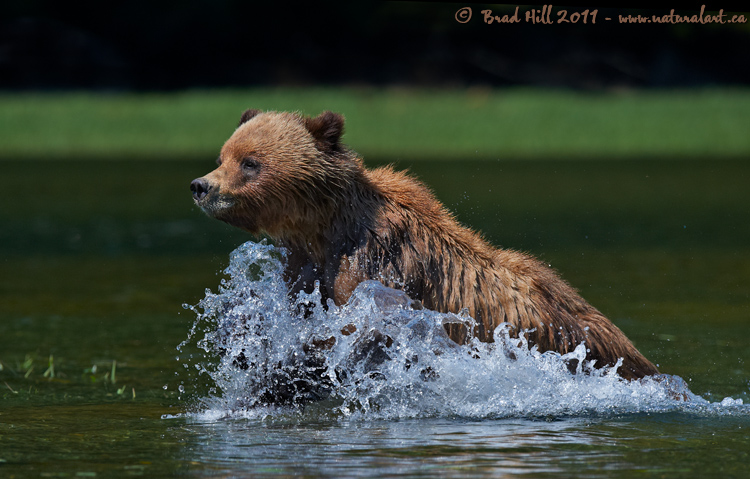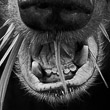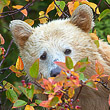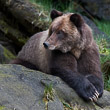Availability: Undetermined - Enquiries?
In the Field
The Breach! Khutzeymateen Inlet (Great Bear Rainforest), BC, Canada. May 31, 2011.
Yeah, yeah...I know - whales breach, bears run. But...when I looked at this image (which was captured in the middle of a long sequence of this bear running in shallow water), the first thing I thought was "hey, it looks like she's breaching...". My image, my title...
This was a really cool behavioural sequence to watch. This bear is very attractive young female grizzly that is just coming to the "breeding" age. For much of the spring of 2011 she was almost always seen in the company of one of a number of different males (bit of a tart, now that I think of it). Anyway...when we saw her this bright sunny afternoon she was alone on a grassy island that was quickly becoming submerged by the rising tide. As we drifted toward the island she suddenly stood up and looked around. Then, for reasons that no one will ever know for sure, she began sprinting back and forth on the island while looking in all directions. At one point she even ran right up to our Zodiac boat and stood partially upright and thoroughly checked out the inside of our boat (it almost felt like she was going to climb aboard to thoroughly check out the interior). Now, the issue WASN"T that she had panicked because the island was being submerged - these bears swim back and forth across the inlet as easily as we walk across a street (so she WASN"T looking in the Zodiac to see if there was room for her!). Did she suddenly realize that her male "buddy" (platonic I'm sure) had left her and she was searching for him? Did she think he we might have offered him a ride in our Zodiac and he might be one of the passengers? Simply can't say - but it sure the heck was an interesting (albeit somewhat confusing) thing to watch (and gave us some great photo ops!).
With wildlife, action usually breaks out when you least expect it - this is pretty much a rule of life. This bear is a perfect example of that - we had no reason whatsoever to expect it to treat us to this display of running. One key to capturing action effectively (whether you want to freeze the action - as I did here - or create more artistic motion blurs, is being ready for it. And, a part of "being ready" is having your camera set up correctly. I utilize a combination of three key features on my Nikon D3s to ensure I'm ready for action. First (and second) I combine the multiple Shooting Bank feature with the Auto ISO function - I set up 3 "Shooting Banks" (Bank A, B, and D) with different Auto ISO settings. Bank A is my "all-around shooting bank" (with big lenses!) and I set the longest permissible shutter speed to around 1/200s (sometimes I tweak this shutter speed in the field, depending on the lens I'm using and, of course, the available light) with an ISO cap of about ISO 3200. Bank B is my "Motion Blur" bank where I have longest permissible shutter speed of 1/30s set (and with the max ISO set only to about ISO 800). Bank D is my "Freeze Motion" bank where I set the shutter speed to 1/2000s (or sometimes higher) and the max ISO up to 6400 (or occasionally even higher).
Why Shooting Banks A, B, and D (why skip "C")? Hold on...it will become clear in a second. I also program my function button so that when I push it and toggle the command dial it instantly shifts between the Shooting Banks. When I'm on Shooting Bank A one toggle to the right brings me instantly to Shooting Bank B - my motion blur bank. Or, if I toggle it one "click" to the left, it "wraps around" and shifts me to Shooting Bank D - my freeze motion shooting bank. So...when I'm shooting "normal" stuff (on Shooting Bank A) I'm only one button push (and simultaneous toggle dial) from being ready to play with motion blurs or freezing action. Which is the main reason I captured this image - I didn't have to waste virtually ANY time monkeying around with my camera settings...I saw the action and a fraction of a setting later I was shooting it.
Setting up your shooting banks like this is a little thing. And possibly a bit of an anal thing. But it DEFINITELY helps me dramatically reduce the number of shots I miss when in the field (and definitely ends up getting the people I'm shooting with ticked off at me when I get the shot and they miss it!). Try it, and keep it a secret - it's a GREAT way to lose friends!
NOTE: This image was captured in a region of British Columbia known as "The Great Bear Rainforest". I offer both instructional photo tours and "photo op only" photo tours into the Great Bear Rainforest each spring and autumn. If you're interested in more information about one of these tours, details are available on the Photo Tours page of this website!
Behind the Camera
The Breach! Khutzeymateen Inlet (Great Bear Rainforest), BC, Canada. May 31, 2011.
Digital Capture; RAW 14-bit format; ISO 280.
Nikon D3s with Nikkor 400mm f2.8 VR lens. Hand-held from floating Zodiac inflatable boat (VR on and in normal mode).
1/2000s @ f5; -0.67 stop compensation from matrix-metered exposure setting.
At the Computer
The Breach! Khutzeymateen Inlet (Great Bear Rainforest), BC, Canada. May 31, 2011.
RAW Conversion to 16-bit TIFF, including first-pass/capture sharpening using Phase One's Capture One Pro 6. Three raw conversions varying in exposure settings over a 1.5 stop range - from -0.25 stops to retrieve highlight detail in the splashing water through to +1.25 stops to extract shadow detail.
Further digital corrections on 16-bit TIFF file using Adobe's Photoshop CS5 and LightCraft's Lightzone. Photoshop adjustments including blending of 3 exposure versions, selective exposure and tone curve adjustment, selective colour saturation and desaturation, and final sharpening for web output. Final tonemapping and contrast/tone tweaking - especially to midtones on bear's back and highlights in splashing water - performed with LightZone using the tonemapper/re-light tool.
Conservation
The Breach! Khutzeymateen Inlet (Great Bear Rainforest), BC, Canada. May 31, 2011.
Ten percent of the revenue generated by this image will be donated to Raincoast*.
Species Status in Canada**: Special Concern (May 2002).
While Grizzly Bears (Ursus arctos) are not technically listed as "Endangered" in Canada, they have been extirpated from most of their historical range. Grizzly Bears are far more sensitive to intrusion/disturbance in their habitat than are Black Bears and are being increasingly forced into marginal habitat by human encroachment. The Great Bear Rainforest along the central and northern coast of British Columbia is one of the last strongholds of the Grizzly Bear in Canada, and even this population is coming under increasing pressure.
On December 18, 2017 the government of British Columbia banned grizzly hunting across the entire province. This major conservation victory came after decades of tireless work by many dedicated conservationists and ecologists and, most importantly, it reflects the opinion of the vast majority of British Columbians. And, it means that AT LEAST while the current government remains in power grizzlies are finally "safe" in British Columbia.
Now that we've at least temporarily won the battle to save grizzlies in BC, it's time to re-focus our efforts toward protecting ALL of BC's carnivores, including Gray Wolves, Black Bears, Cougars, Wolverines, and more! Simply put, there are no ecological, economic, or ethical arguments supporting the trophy hunting of carnivores.
In a great first step towards ending the hunting of carnivores throughout BC the Raincoast Conservation Foundation has developed a program designed to protect ALL carnivores within the Great Bear Rainforest. Details about this program can be found on this page on Raincoast's website. Check it out and, better yet, make a donation to help Raincoast purchase the remaining commercial hunting tenures in the Great Bear!
*The Raincoast Conservation Society (and Foundation) is an effective and efficient organization that has been fighting for protection of this unique habitat. If you are looking for a meaningful way to contribute to the conservation of this amazing ecosystem, Raincoast will provide maximal "bang" for your conservation dollars.
**as determined by COSEWIC: The Committee on the Status of Endangered Wildlife in Canada

























